If you are looking for a China train tour, this 15-day highspeed train China tour package is recommended to you. Compared with planes, the high speed train is more punctual and is less influenced by weather conditions. Taking the high speed train to travel around China has become the most popular way for visitors from all over the world. During this itinerary, you will explore China by taking the Beijing Kunming high speed train, Kunming Dali high speed train, and Kunming Shanghai high speed train. Along your way, you can look out of the window of the high speed train to appreciate the scenery outside. You can see the topographic changes and various landscapes from eastern China to western China, which is an indispensable part of your high speed China train tour with Yunnan. Come and join us on this perfect China high speed train tour.

Welcome to Beijing! Your High Speed Train Tour will start from Beijing officially. Our guide will be waiting for you at Beijing airport and transfer you to the arranged hotel.
Beijing is China’s capital, a window for you to know about China, Chinese people, and Chinese culture. Beijing has a very long history. As early as 700,000 years ago, in Zhoukoudian Village in the southwest of Beijing, primitive tribes named “Beijing Ape Men” lived here, who could use simple tone tools and walk upright like human beings. The Beijing Ape Men might be one of the ancestors of the Chinese. In history, many dynasties established their capitals here, including the Yuan Dynasty (1271-1368), the Ming Dynasty (1368-1644), and the Qing Dynasty (1636-1912), so it owns the most historical relics and heritages in the world.
In the morning, after a prepared breakfast in the hotel, you will first visit Tian’anmen Square. It is the world’s largest public square with an area of approximately 440 thousand square meters, 880 meters long from north to south and 500 meters wide from west to east. Therefore, as many as 1,000,000 people can gather in Tian’anmen Square for celebrations on a grand scale. For instance, at 22:00 (Beijing time) on July 13, 2001, Beijing was declared to be the host city of the Olympic Games in 2008. About 40,000 people cheered up on Tian’anmen Square to share such enjoyment. Most importantly, on October 1, 1949, the square witnessed the establishment of the People’s Republic of China, where Chairman Mao Zedong declared the founding of New China to the world on the Tian’anmen Gate Tower in north of the square. More than 300,000 people gathered in the square to celebrate this significant moment. The Tian’anmen Gate Tower is 34.7 meters high, 66 meters long, and 37 meters wide. You will see five doorways at the bottom and the middle one is the largest. During the Ming and Qing dynasties, only the emperor enjoyed the privilege to pass through the middle doorway. The portrait of Chairman Mao is hung right above the middle doorway.
Then we will appreciate the Forbidden City (closed on Mondays) neighboring Tian’anmen Square. The Forbidden City wins its fame as one of the world’s five greatest palaces with the other four – Palace of Versailles, Buckingham Palace, White House, and the Kremlin. The Forbidden City is the emperors’ living and “working” place in the Ming and Qing Dynasties, and 24 emperors (14 Ming emperors and 10 Qing emperors) had ever taken their powers here. The “forbidden” means it forbids the ordinary people to enter in order to maintain the emperors’ mystery and majesty. The Forbidden City is composed of two main parts – the outer court and the inner court. The outer court includes the Hall of Supreme Harmony, the Hall of Central Harmony, and the Hall of Perfect Harmony for the royal celebrations; the inner court is centered on the three main palaces – Palace of Heavenly Purity, Palace of Union and Peace, and Palace of Earthly Tranquility with the subordinate halls behind the outer court for the emperors, the empresses, and the concubines to live. Behind the inner court is the royal garden. You will see ancient trees of over 300 years, artificial hills, pavilions, flowers, and herbs. The roads in this garden are paved with colorful pebbles that form various patterns of more than 900 including Chinese traditional characters, landscapes, flowers, and animals. At Mid-Autumn Festival, the emperor would enjoy the moon with his family members in the royal garden.
After lunch, we will visit the Temple of Heaven. The emperors in the Ming and Qing Dynasties worshiped heaven and prayed for good harvests at the temple. The Temple of Heaven built in 1420 is located in the south of Beijing and covers over 2,730 square kilometers. It is surrounded by a long wall. The wall in the north part is in an arc and the wall in the south is right-angled, representing the ancient Chinese cosmology – round sky and square earth. The most famous building in the temple is the Hall of Prayer for Good Harvests. This hall is supported by 28 pillars made of nanmu (a precious wood even more valuable than gold). The wooden pillars are arranged in three circles from inside to outside. The 4 columns of the inner ring, nearly 20 meters high, are symbols for the four seasons; the 12 columns of the second ring stand for the 12 months; the outer 12 columns together with the 12 columns of the second ring represent 24 Chinese solar terms.
Then we will visit the Summer Palace. Built in 1750, it was the imperial garden in the Qing Dynasty. It is mainly composed of Kunming Lake and Longevity Hill. The garden occupies an area of about 3 square kilometers, of which Kunming Lake accounts for three fourths. The architecture style of the garden imitates the landscapes in the south of China. The Summer Palace is the favorite palace of Empress Dowager Cixi. In the Hall of Benevolence and Longevity, there is a folding screen that is carved with over 120 Chinese characters – “Shou” which means longevity in different writing styles. It was a gift for Cixi’s birthday.
Your first day to visit Beijing will be over, and we will transfer you to the hotel for a rest.
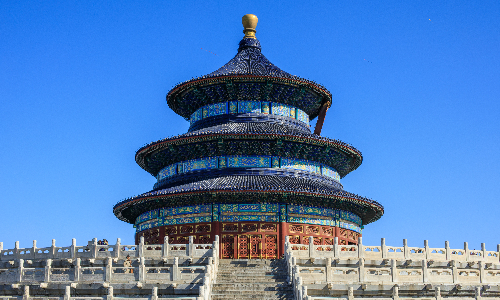

In the morning, we will drive you to the Chang Tomb, one of the thirteen Ming Tombs. The Ming Tombs are located in the Changping District of Beijing, about 50 kilometers away to the Forbidden City. We will drive northwest for about an hour to get there. The Ming Tombs are the burial sites for 13 Ming emperors, 23 empresses, 2 princes, over 30 concubines, and 2 eunuchs. The Chang Tomb is the largest one in scale, covering 120 thousand square meters. It is also the earliest one among the Ming Tombs, built in 1409. Emperor Yongle and his empress were buried here. Chang Tomb consists of the overground palace and the underground palace where the emperor’s body is preserved. You can just visit the overground buildings because the underground palace has not yet been excavated so far.
After finishing a provided lunch, you will come to the Badaling Great Wall, about 40 kilometers away in northeast of Chang Tomb. It takes about 40 minutes to drive there. Badaling Great Wall is a popular section of the Great Wall built in the Ming Dynasty. The Great Wall was built for defending against enemies and it had been built since the Western Zhou Dynasty (1046 BC - 771 BC) lasting over 2,000 years. The long wall with a total length of 20 thousand kilometers winds along the northern borders of ancient China. The Great Wall is composed of different fortifications like fortresses, passes, beacon towers, and watch towers that were controlled by military forces. Climbing onto the Great Wall on foot is really challenging, so there is an old Chinese saying goes, “One who fails to reach the Great Wall is not a hero”.
On your way back to the hotel from the Badaling Great Wall, you will pass by the Water Cube and the Bird’s Nest, which were the Olympic venues of the 2008 Beijing Summer Olympic Games. The Water Cube was built for the swimming competitions in 2008 and will be used for the ice competitions like curling in the 2022 Beijing Winter Olympic Games. The Bird’s Nest was the main stadium in the 2008 Olympic Games. It covers an area of 20.4 hectares and can accommodate about 91,000 people. You will take a photo stop at the Water Cube and Bird’s Nest for minutes to take pictures, and then you will return to the hotel.
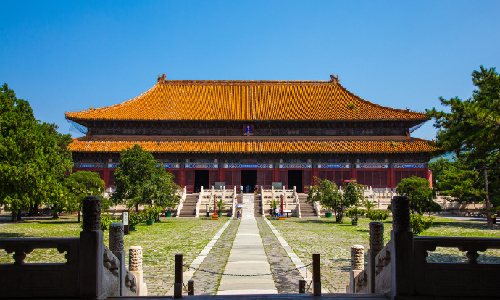

 Kunming
Kunming The second station of your 15-day High Speed Train Tour is Kunming. This morning, you will head for Kunming by taking the estimated train G403 08:00/18:49. After arrival, your Kunming guide will meet you at the railway station and transfer you to the hotel. Kunming is in southwest of Beijing with a straight-line distance of about 2,182 kilometers. It is the provincial capital of Yunnan Province. It is located in the middle of the Yunnan-Guizhou Plateau with an average altitude of 1,891 meters, surrounded by mountains on three sides and facing the Dianchi Lake in the south. It is known as the “Spring City” because the climate here is like spring all the year round. The mild climate contributes to a perfect environment for flowers. So, Kunming has also been praised as the “Flower City” that more than 400 varieties of flowers blossom consecutively all year round. Among them, camellia, orchid, azalea, and Primula malacoides are the most attractive.
After a provided breakfast, your first stop in Kunming is the Stone Forest. It will take about 1 hour (about 75.5 kilometers) to drive eastward from Kunming. The Stone Forest in Yunnan is famous as “the essence of the karst landforms”. It covers an area of 400 square kilometers and has the longest evolution history of karst landform and the widest distribution. Wandering in the Stone Forest, you will see different shapes of stone pillars and stone peaks, such as human shape, mushroom shape, and sword shape. The Stone Forest scenic area is divided into several parts, including the Major and Minor Stone Forest Areas in the center, Bushao Mountain Area in the northwest, Ancient Ganoderma Area in the south, and so on. The most attractive areas are the Major and Minor Stone Forest Areas. Dense stone peaks stand upright together, forming different views, such as “Lotus Peak”, “Swords Pool”, and “Phoenix Combing”.
After an arranged lunch, we are going to return to the urban area and visit Green Lake Park. The Green Lake Park is located at the foot of the Luofeng Mountain, honored as “a green jade inlaid in the city”. Green Lake Park is 21 hectares, of which the Green Lake takes up to 15 hectares. Green Lake originally was part of Dianchi Lake, but with the fall of the water level, it was separated from the main lake. Two long embankments cross at the center of the lake, dividing the lake into four areas. The joint area of the two embankments is an eyot where a pavilion stands. Lots of willows grow in the park and lotus grows in the lake. Because of the warm temperature in Kunming, every year, thousands of black-headed gulls flying from Siberia to Green Lake Park for spending the winter here add much vigor to the park. This beautiful view deserves a visit.
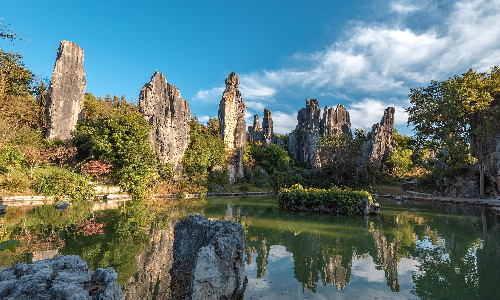
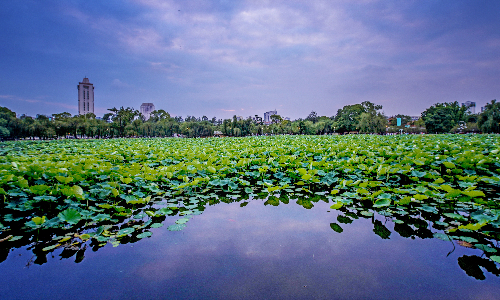
 Dali
Dali In the morning, you will take the estimated high speed train G8673 09:04/11:26 to Dali, another hot tourist city in Yunnan Province. Our guide will meet and greet you at the railway station and then take you to the local restaurant for lunch.
In the afternoon, you will first visit the Three Pagodas of the Chongsheng Temple. Chongsheng Temple occupies 66.7 hectares and has two main parts – the front part including the Three Pagodas and the rear part housing the Chongsheng Temple, known as the “Capital of Buddhism” in Yunnan Province. Among the Three Pagodas, the biggest one is called “Qianxun Pagoda” (“qian” means thousand and “xun” is a unit of height in ancient China). Qianxun Pagoda has an architectural style of the Tang Dynasty (618 - 907). It is 69.13 meters high, built during 833-840. The two smaller ones were built during 1108-1172 particularly in the style of the Song Dynasty (960-1279). The two made of bricks are 42.17 meters high. They are in north and south respectively in a distance of 70 meters to the Qianxun Pagoda, forming an isosceles triangle. In ancient times, Dali had always suffered floods. In the Chinese legend, the dragon controls the water, so to prevent the floods caused by the dragon, people thought they should threaten the dragon. As the enemy of the dragon was the roc, people built golden rocs on the tops of the pagodas to frighten the dragon.
Then we will come to the Dali Old Town, 1.5 km away from Three Pagodas of the Chongsheng Temple. The Dali Old Town was built in 1382 in the Ming Dynasty. The old town has a traditional Chinese chessboard layout with five streets traversing the whole town from south to north and eight streets from west to east. When you arrive, you shall not miss the most famous photo site – the South Gate of Dali Old Town. Entering Dali Old Town from the South Gate, you will see a bustling street leading directly to the North Gate. A lot of shops selling handicrafts, silver and jade ornaments, and fabrics of the Bai ethnic group stand side by side along the street. Another must-visit is Huguo Road, also known as Foreigner’s Street. You may see rows of restaurants, cafes, and tea shops on both sides. Most of the shop signs and advertisements are written in English or other foreign languages, attracting foreigners from all over the world.

Except for the historic and cultural heritages in Dali, the natural beauty of Dali is also appealing. On the second day here, in the morning after a provided breakfast, you will take a cruise on the Erhai Lake for about 2 hours to enjoy its natural landscapes. Erhai Lake covering an area of 246 square kilometers is the second largest freshwater lake in Yunnan, honored as the “mother lake” by the Bai nationality. The ancestors of the Bai people called it “Golden Moon”. It is a Chinese tradition to admire the moon in the evening of the Mid-Autumn Day, and so do the Bai people. On the night of the 15th day of the 8th Chinese lunar month, the Bai people will row a wooden boat on the Erhai Lake to enjoy the moon with their family members. The bright moon, the cloud, the quiet Erhai Lake and the boats on the lake compose a magnificent picture.
In the afternoon, you will visit Xizhou Ancient Town. Xizhou Ancient Town is an ideal place to learn about the culture of the Bai nationality. It has preserved a large number of residential buildings with distinctive features of Bai nationality in the Ming and Qing Dynasties and in the Republic of China (1912-1949). Among them, the most famous buildings are Yan Family Courtyard and Yang Family Courtyard. Besides, you could experience the tie-dye of the Bai nationality. It’s a unique experience of your Dali tour. In addition, many places that are popular for people to take photos in the Xizhou Ancient Town are waiting for you to discover.

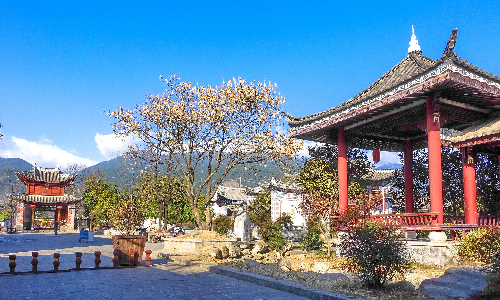
 Lijiang
Lijiang This morning, you will leave Dali and take the estimated train K9621 10:05/12:46 to Lijiang after an arranged breakfast. Our guide in Lijiang will pick you up at the railway station.
In Lijiang, the most famous tourist site is the Lijiang Ancient Town, which is an important town on the Ancient Tea Horse Road, boasting more than 800 years of history. The town is established on a plateau at the foot of Jade Dragon Snow Mountain, with an altitude of 2,416 meters. It features various bridges and water lanes. The old streets in the town are paved with red breccia. Most of the folk dwellings are made of wood and earth, and the overall layout and architecture style integrates the architectural essences of other nationalities like Han, Bai, Yi, and Tibetan nationalities. Most of the locals are the Naxi people and the ancient Dongba culture (the main culture of Naxi people) is well-preserved in the town. They speak their Naxi language, believe in Dongba () Religion, and use Dongba characters which are rare primitive hieroglyphs still in use in the world. You will see Dongba characters everywhere, including on the tablets of many shops. Getting to know some words in another language is always a good thing. You can learn some simple local words from the local people.
The most famous building here is the Mufu Palace where a famous Chinese TV series about the vicissitude of the Mu family was shot here. The palace covers over 30 thousand square meters. The Mu family was appointed as the hereditary chieftain of Lijiang by emperors to govern this place during the Yuan (1271-1368), Ming, and Qing Dynasties. They had been the chieftains of Lijiang for over 470 years since 1253. The Mufu Palace of Lijiang is like the Forbidden City of Beijing for its political and cultural status. As a local saying goes, “Lijiang tour is in vain without visiting Mufu Palace.”
Another hot site is Sifang Street Square where you can taste local food. Dozens of restaurants are on both sides of the streets. Each restaurant here serves a variety of Yunnan rice noodles, so it is also called “Lijiang Rice Noodle Street”. The local residents also celebrate their festivals here. You might watch people performing songs and dances here if you happen to come here during festivals.


After an included breakfast in the morning, you will visit the Jade Dragon Snow Mountain, 20 kilometers north of Lijiang Ancient Town. We will drive about 40 minutes to get there. Jade Dragon Snow Mountain means “mountain in heaven” in the Naxi language. It has been regarded as the sacred mountain in the Naxi people’s hearts because they believe that it is the incarnation of their protective god “Sanduo”. The 13 snow-capped peaks of the snow mountain are arranged from south to north, like a flying jade dragon, so the mountain is called Jade Dragon Snow Mountain. The highest peak at an elevation of 5,596 meters is perennially covered with snow.
Three cableways are provided for you to appreciate the scenery of Jade Dragon Snow Mountain. For the consideration of time limits, you may choose one route to visit the mountain. The most popular cable route is the Big Cable Way to Glacier Park. It is 2,914 meters long, climbing a vertical distance of 1,150 meters in about ten minutes. This cableway starting from an altitude of 3,356 meters will take visitors up to the height of about 4,506 meters, and then visitors will climb over 100 meters to arrive at the peak of about 4,680 meters to admire the snow mountain. However, this route is not suitable for the elders and people who have serious altitude sickness. This route will be closed for the consideration of bad weather. The second way is the Middle Cable Way. The destination of this route is the Yak Plateau. This cableway is 1,200 meters long and climbs a vertical distance of 360 meters. We usually arrange the third route – the Small Cable Way for you. It leads to Spruce Plateau. Spruce Plateau is at a relatively low elevation, suitable for most visitors. It is a beautiful alpine meadow surrounded by dense and primitive spruce forest. In Naxi culture, the Spruce Plateau is a place for young couples who are not allowed to get married to die for love.
Down the Jade Dragon Snow Mountain, we will visit Blue Moon Lake. Blue Moon Lake was formed by melting water from the snow and ice on Jade Dragon Snow Mountain. The lake water reflects the blue sky and looks like a blue moon from a distance.
After a provided lunch, you will visit Baisha Village in the afternoon. Baisha Village, located at the southern foot of Jade Dragon Snow Mountain, 10 kilometers north of Lijiang Ancient Town, is the origin of the Mu family regime. Baisha, the ancient capital of the Naxi nationality, was the political, commercial, and cultural center of Lijiang. Here, you should not miss the Baisha Mural Paintings. The painting work of these murals lasted for more than 300 years from the early Ming Dynasty and reached its heyday in the early Qing Dynasty. The murals that have been preserved in Dabaoji Palace are the most in quantity in Lijiang. A total number of 558 paintings integrating Han, Tibetan, and Naxi cultures describe stories from Tibetan Buddhism, Confucianism, and Taoism.
Then, we will drive south to Shuhe Ancient Town. It is between Lijiang Ancient Town and Baisha Village. It takes about 20 minutes (about 6 kilometers) to get there. Shuhe in the Naxi language means “a village at the foot of the mountains”. It is one of the earliest settlements of Naxi ancestors in Lijiang. As an important town along the Ancient Tea Horse Road that promoted the trade of various commodities, Shuhe Ancient Town became a famous “leather village”, producing leather shoes, saddles, fur coats, and other leather products. After you finish the visit to Shuhe Ancient Town, you will get back to the hotel in Lijiang by car.


 Shangri-La
Shangri-La After breakfast, we will drive northwest to Shangri-La, about 180 kilometers away from Lijiang. We will drive for about 3 hours. On your way to Shangri-La, you will pass by the First Bend of the Yangtze River after one hour’s driving. The Yangtze River is the longest river in China, originating from the Qinghai-Tibetan Plateau and flowing through Yunnan Province. When it passes through Shasongbi Village in Shangri-La, the river suddenly takes a sharp turn and flows to the northeast, forming a rare V-shaped bend. People call this wonder “the First Bend of the Yangtze River”.
And then after an hour, you will arrive at the Tiger Leaping Gorge. The Tiger Leaping Gorge is 17 kilometers in length and is divided into three sections, the upper section, the middle section, and the lower section. The vertical height difference of Tiger Leaping Gorge is more than 3,900 meters, famous as one of the deepest gorges in the world. The narrowest part of the gorge is only about 30 meters. It is said that a tiger can jump over the gorge by stepping on a stone in the middle of the river, so the gorge is called Tiger Leaping Gorge.
You will have lunch on the way and arrive in Shangri-La in the afternoon. Shangri-La is a Tibetan settlement. Shangri-La means “sun and moon in the heart” in Tibetan, which symbolizes a land of idyllic beauty. Located in the northwest of Yunnan Province, it borders Sichuan and Tibet, forming unique landscapes of snow mountains, canyons, alpine lakes, vast alpine grasslands, as well as virgin forests. So, Shangri-La wins its fame as “a garden on the mountain” and “the kingdom of animals and plants”.

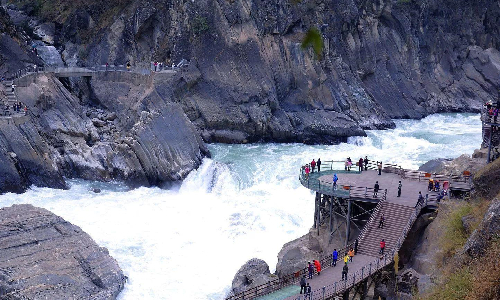
After a served breakfast, you will first visit Songzanlin Monastery. It is the largest Tibetan Buddhist temple in Yunnan Province. Songzanlin Monastery was built on the mountain from 1679 to 1681. The whole monastery is quite similar to the Potala Palace in Lhasa, so it is also known as the “Small Potala Palace”. Songzanlin Monastery is surrounded by an elliptical wall, and its two main halls, Zhacang and Jikang are located at the top in the center. Except for the exquisite buildings, many precious relics of Tibetan Buddhism are preserved, such as gold Buddha statues, Buddhist paintings, and censers. Therefore, Songzanlin Monastery is known as the “Museum of Tibetan Art”. Please pay attention that when you walk into the temple, you shall take off your sunglasses and hat and dress properly. And it is disrespectful if you point at the Buddhist statues. Picture taking is prohibited inside the monastery.
After an included lunch, you will visit Potatso National Park. Potatso National Park, with an average elevation of about 3,500 meters, is composed of three major scenic areas: Shudu Lake, Militang Pasture, and Bita Lake. Shudu Lake is one of the largest alpine lakes in Shangri-La. A 3-kilometer long boardwalk is built around the lake, allowing you to see the beauty of the lake from different angles. Hiking is the best way to appreciate the lake, and you might be lucky enough to come across cute squirrels.
After leaving the park, you will visit a local Tibetan Family, chatting with the host and tasting butter tea to experience the local Tibetan life.

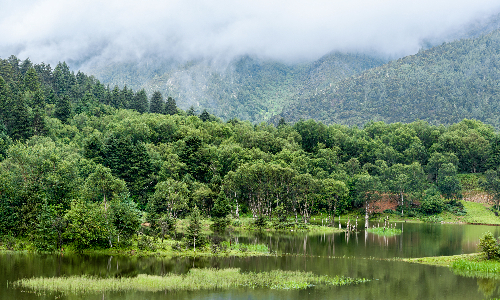
 Kunming
Kunming After a provided breakfast, you will check out and take the estimated flight MU5932 08:50/10:05 to Kunming. Our guide will be waiting for you at the airport.
After lunch, you are going to visit Western Hills. Western Hills scenic area is in the western suburbs of Kunming, about 15 kilometers away from the city center. It is comprised of undulating hills including Huating Hill, Taihua Hill, Luohan Hill, and so on. One must-visit place at Western Hills is the Dragon Gate. It consists of a group of grottoes and tunnels connecting the grottoes that are chiseled on the cliff. A lot of inscriptions written by ancient Chinese have been preserved. The Dragon Gate can be described as a museum with a rich collection of Chinese calligraphy and stone-carving art.
After the Western Hills, you will be transferred to the hotel for a good rest and prepare for the last stop of your High Speed Train Tour, namely, Shanghai.


 Shanghai
Shanghai In the morning, you will take the estimated high speed train G1372 08:21/19:44 to Shanghai. Shanghai is in northeast of Kunming with a distance of about 2,350 kilometers. Upon arrival, our shanghai tour guide will be waiting at the station and transfer you to the hotel.
Shanghai, the largest city in China, is one of the four municipalities directly under the central government. It is the economic, financial, trade, and shipping center of China. Shanghai, located at the estuary of Yangtze River, has the largest industrial base and the foreign trade port in China. In the past, Shanghai was just a small town with fishing and cotton textile industries as its main business. After the Reform and Opening Up in the 1990s, Shanghai has become the most prosperous economic center in China and the largest trading port in the world.
After breakfast in the morning, you will firstly visit Jade Buddha Temple. Jade Buddha Temple is honored as one of the top ten views in Shanghai. Although it is located in the bustling downtown area of Shanghai, it is a pure land where you can find tranquility. Jade Buddha Temple is an imitation of the temples in the Song Dynasty (960-1279). The central axis is lined with three main buildings – Hall of Heavenly Kings, the Great Buddha’s Hall, and the Jade Buddha Tower. The Jade Buddha Tower enshrines a jade Buddha which is 1.95 meters high and carved from a single piece of jade. The rim of its cassock and the bangle around its right arm are decorated with more than one hundred pieces of emeralds, agates, and other precious gems.
Then, you will visit the Yu Garden (closed on Mondays). Yu Garden is a famous classical garden in the south of the Yangtze River. It was originally a private garden in the Ming Dynasty with a history of more than 450 years. The owner of the garden was Pan Yunduan, who had served as the governor of Sichuan Province. He built Yu Garden as a residence for his father to enjoy his old age. “Yu” has the meaning of “peace” and “safeness” in Chinese. The garden was finished more than 20 years later since it began to be built in 1559. However, his father died before the Yu Garden was completed. As a Chinese classical garden, it attracts a great number of visitors every year. President Clinton, Queen Elizabeth II, and many other dignitaries and celebrities have visited it.
In the afternoon, you are going to visit Tianzifang Market. Tianzifang Market, located in Taikang Road, is a place where Shanghai’s creative industries gather. It has been transformed from Shanghai’s unique Shikumen-style buildings (characteristic residential buildings of Shanghai with stone-framed gates). There are more than 40 handicraft shops as well as more than 20 art studios. Walking in Tianzifang Market through the labyrinth-like lane, boutique shops, art workshops, outdoor restaurants and cafes, art galleries will inadvertently jump into your sight. Apart from buying some unique souvenirs, you can also taste local food and snacks here.
Then you will visit Shanghai Tower where you could enjoy a bird’s eye view of the whole city. It covers a total floor area of 578,000 square meters, with 127 floors above ground and 5 floors underground, and a total height of 632 meters. It is the highest building in China and the second highest in the world. You can take the fastest elevator in the world to get to the 118th floor (546 meters high) in 55 seconds at a speed of 18 meters per second. Here, you can appreciate the beautiful scenery on both sides of the Huangpu River as well as Shanghai.
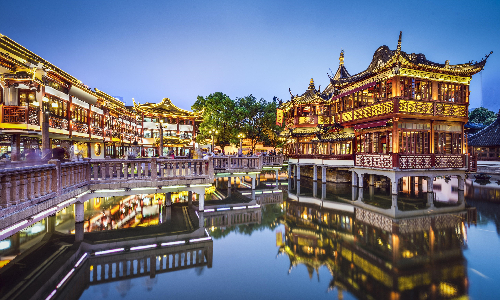
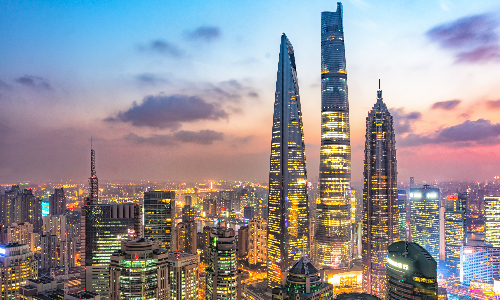
In the morning, we will drive you to Zhujiajiao Water Town. Zhujiajiao Water Town is located in Qingpu District, southwest of Shanghai. It is about 47 kilometers away from Shanghai downtown and we will drive about an hour to get there. In the town, there are nine old streets that are built along the river with thousands of houses. Among them, the North Street is the best-preserved ancient street with Ming and Qing architectural styles. As several river channels pass through Zhujiajiao Water Town, there are 36 bridges over the river channels. You should not miss Fangsheng Bridge, a five-hole stone arch bridge with a length of 70.8 meters and a width of 5.8 meters. As the longest, largest, and highest five-hole arch bridge in Shanghai, it is called the “Top Bridge in Shanghai”. Fangsheng Bridge is the best place for watching sunrise and sunset.
You will have lunch in Zhujiajiao Water Town. Try some local food such as Zongzi (made of sticky rice and streaky pork or yolk), Zharou (a kind of streaky pork that is tied up by bamboo leaf), and other snacks.
In the afternoon, you will drive back to Shanghai to visit the Bund. The Bund is 1.5 kilometers long on the west bank of the Huangpu River, with 52 classic buildings in different styles standing on it. It is a nice place for strolling and taking pictures.
Then you will come into a commercial walking street – Nanjing Road. Famous as one of the top ten famous pedestrian streets in China, it is a paradise both for shopping and dining. Nanjing Road is the earliest commercial street established after Shanghai opened its commercial port. Since the early 20th century, Nanjing Road has been a gathering place for department stores. Now there are not only old department stores like Yong’an Department Store, Hualian Department Store, and Silk Department Store but also large shopping malls. For food, you can taste local food from several Chinese old brands including Small Steamed Buns and Fresh Pork Moon Cakes.
Your 15-day high speed train tour is coming to an end in Shanghai. Your guide will take you to the airport according to your flight. Hope you have a pleasant journey and wish to meet you again in other Chinese cities.

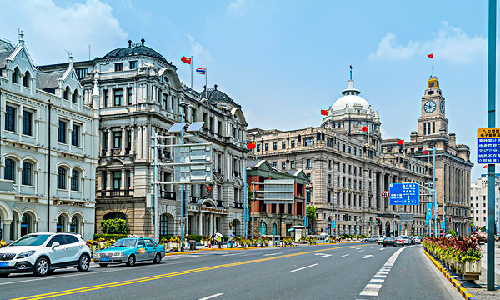
Author: Yang Beibei
Proofreader: Vivian Zhou
| City | Five Star hotel list | Four Star hotel list |
|---|---|---|
| Beijing | Sunworld Dynasty Hotel Beijing Wangfujing | Sunworld Hotel Wangfujing |
| Kunming | Grand Park Kunming | UChoice Hotel |
| Dali | The One Hotels & Resorts | Landscape Hotel |
| Lijiang | Wonderport International Hotel | Lijiang Wangfu Hotel |
| Shangri-La | Paradise Hotel | Ri Yue Xing Cheng Hotel |
| Shanghai | Ocean Hotel Shanghai | Courtyard by Marriott Shanghai Central |
 |
![]() About your child or infant, please contact us for a discounted price.
About your child or infant, please contact us for a discounted price.



We started with a few days in Beijing & ended in Shanghai, from where we visited the Forbidden City and Great Wall. In between we visited Terra Cotta Warriors Museum, Panda Base, Shanghai Disneyland.

We had a wonderful holiday in China which will remain long in the memory. China is a breathtakingly beautiful country full of splendid temples and palaces, mountains and rivers, peaceful rural scenes and bustling shopping streets.
 QUICK ENQUIRY
QUICK ENQUIRY